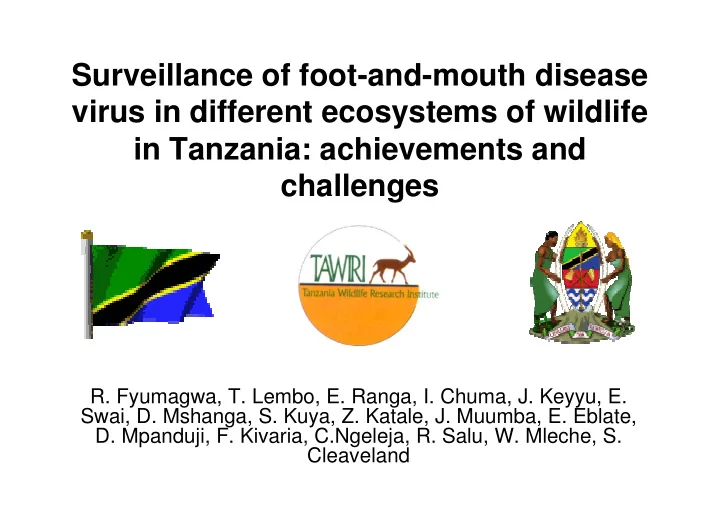

Surveillance of foot-and-mouth disease virus in different ecosystems of wildlife in Tanzania: achievements and challenges R. Fyumagwa, T. Lembo, E. Ranga, I. Chuma, J. Keyyu, E. Swai, D. Mshanga, S. Kuya, Z. Katale, J. Muumba, E. Eblate, D. Mpanduji, F. Kivaria, C.Ngeleja, R. Salu, W. Mleche, S. Cleaveland
Background on FMD research initiative in Tanzania • December 2009: BBSRC-CIDLID projects awarded (two projects [Cleaveland and Parida]) • January 2010: Kick-off meeting of SACIDS project [Rweyemamu et al] in Arusha • 2010: Commencement of SADC FMD project in Southern Africa. • Critical mass of research capability for FMD in Tanzania and neighbouring countries • Many common goals • Sharing of research resources • Open communication
Research program partners • Tanzania: (4 main players) • – Central Veterinary Laboratory (CVL) • – Sokoine University of Agriculture (SUA) • – Tanzania Wildlife Research Institute (TAWIRI) • – National Epidemiology Unit (NEU) • Zambia: • – University of Zambia (UNZA) • – Central Veterinary Research Institute (CVRI) • SADC Secretariat : SADC-TADs Regional Project • Republic of South Africa : ARC-Onderstepoort Veterinary Institute (OVI) • Botswana: Botswana Vaccine Institute (BVI) • United Kingdom: • – Royal Veterinary College, London • – University of Glasgow • – World Reference Laboratory for FMD, Pirbright (IAH) • – University of Edinburgh (Professor Brian Perry) • India: Indian Immunologicals Ltd. • Uganda: Ministry of Agriculture?
Principal Objectives • FMD dynamics in an endemic region -Spatio-temp distribution -Molecular Epidemiology -Wildlife/Livestock interactions -Correlates of cross-protection -Generation of Antigenic diversity -Determine the role of carriers • Generation of models describing FMD endemicity -Establish the risk factors -In-silico testing of improved local and national control strategies -Develop Field tools • Capacity building/ national strategy -Tailored vaccines -Diagnostic Capability -Research skills -Evidence base for control strategies
Wildlife Conservation in Tanzania � Tanzania has the highest wildlife population in Africa � Tz is a third country in Africa for cattle population (16 million) after Ethiopia and Sudan � Tanzania has reserved 40% of its land cover for conservation purposes (including NPs, GRs, NCA, GCAs, FRs & WMA) � Long international boundary=3861km (bordering 8 countries).
Estimated size of Protected Areas � National Parks (15 NPs)=50,000km 2 � Ngorongoro Conservation Area (NCA) =8,300km 2 � Game Reserves (31 GRs) =>142,000km 2 � Game Controlled Areas (38 GCA) =>75,000km 2 � Selous Niassa Wildlife Corridor (SNWC)= >5,000km 2 � Forest Reserves (FRs)=>89700km 2 � Wildlife Management Areas (16 WMAs) =?
��������������������������������������������
Buffalo population in different PAs (2009-2011 Censuses) • Selous-Mikumi ecosystem • 108,830 • Serengeti ecosystem • 66,284 • Manyara-Tarangire ecosystem • 15,678 • Ugalla GR • 2,167 • Wamimbiki WMA • 618 • Saadani np • 276 • Ruaha-Rungwa ecosystem • 17,514 • Moyowosi-Kigosi ecosystem • 16,663 • Katavi-Rukwa ecosystem • 10,717 • Burigi-Biharamulo GRs • 1790 • Mkomazi np* • 175
Prevalence of FMD virus in Tanzania • Historically Tz was believed to have serotypes A, O, SAT1 &2. • In 2002 sero-survey in buffalo in SNP revealed SAT1,2 &3 • Detection or isolation of the virus has never been performed • Mapping of the distribution of serotypes has never been performed • Livestock vaccination is not based on known circulating serotypes
FMD virus surveillance in wildlife in Tanzania � Systematic surveillance has not been done previously in wildlife � Currently, FMD Surveillance in buffalo is conducted by SADC-TADs and BBSRC- CIDLID projects � SADC-TADs is prioritizing on PAs close to international borders � BBSRC-CIDLID is focussing in northern zone of Tz (SE, Manyara-Tarangire ecosystem, Arusha-Kilimanjaro ecosystem)
Achievements: SADC-TADs FMD Surveillance project • Katavi National Park -31 buffaloes-2010 • Ruaha np – 30 buffaloes-2011 • Mikumi np – 30 buffaloes-2011 • Mkomazi np – 30 buffaloes-2011 • Samples from Ruaha, Mikumi and Mkomazi NP have not been analysed
Results of FMD surveillance in buffaloes in Katavi np-2010 (SADC-TADs); Source: DVS Type of No. of Serotypes No. of % Remarks sample samples samples positivity tested positive Sera 31 Type 0 0 0% Indicating exposure to SAT1 28 90.3% FMD virus SAT2 28 90.3% SAT3 30 96.8% Probangs 30 Type0 0 0% Indicating active SAT1 4 13.3% infection SAT2 0 0% SAT3 0 0%
Some fundamental facts on FMD � Buffalo is increminated as the ’witch, bad guy or a vilain’ when it comes to FMD in many countries. � We have no concrete evidence in Tanzania to conclude that outbreaks that occur in livestock are associated with wildlife. � Therefore, more work is required to establish whether the outbreaks in cattle are derived from a buffalo/wildlife source. � We have seen outbreaks of FMD in livestock in areas where there is no wildlife per se; an indication that livestock movement might be an important factor in the spread of FMD.
Achievements: BBSRC-CIDLID FMD Surveillance Project • Serengeti NP -35 buffaloes-2011 • Ngorongoro Crater -125 buffaloes-2011/12 • Tarangire np -25 buffaloes-2011 • Arusha np -25 buffaloes-2012 Analyses of all samples is in progress
Challenges � Large wildlife populations in free ranging systems (no fenses) � Extensive protected areas (40% of land cover) and remoteness of many of the protected areas � Few trained wildlife vets to undertake surveillance in wildlife � Lack of equipment and finance to deploy several surveillance teams � Many buffaloes are in Game Reserves where trophy hunting is practised. Therefore, difficult to immobilize without a helicopter. � Seasonal migration of wildlife spp.
Recommend
More recommend